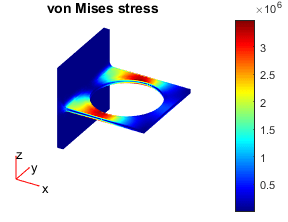Structural Mechanics
With structural analysis, you can predict how components behave under loading, vibration, and other physical effects. This helps you design robust mechanical components by validating designs through simulation and reducing the need for physical testing.
The toolbox lets you perform linear static analysis, transient analysis, modal analysis, and frequency response analysis. A typical programmatic workflow for solving a structural problem includes these steps:
Create a special structural analysis container for a solid (3-D), plane stress, or plane strain model.
Define 2-D or 3-D geometry and mesh it.
Assign structural properties of the material, such as Young's modulus, Poisson's ratio, and mass density.
Specify a damping model and its values for a dynamic problem.
Specify gravitational acceleration as a body load.
Specify boundary loads and constraints.
Specify initial displacement and velocity for a dynamic problem.
Solve the problem and plot results, such as displacement, velocity, acceleration, stress, strain, von Mises stress, principal stress and strain.
Approximate dynamic characteristics of a structural model by using reduced order modeling (ROM).
Functions
Live Editor Tasks
| Visualize PDE Results | Create and explore visualizations of PDE results in the Live Editor (Since R2022b) |
Objects
StructuralModel | Structural model object |
ReducedStructuralModel | Reduced-order structural model results (Since R2019b) |
StaticStructuralResults | Static structural solution and derived quantities |
TransientStructuralResults | Transient structural solution and derived quantities |
ModalStructuralResults | Modal structural solution |
FrequencyStructuralResults | Frequency response structural solution and derived quantities (Since R2019b) |
Properties
| StructuralMaterialAssignment Properties | Structural material property assignments |
| StructuralDampingAssignment Properties | Damping assignment for a structural analysis model |
| StructuralSEIAssignment Properties | Superelement interface assignment for structural model (Since R2019b) |
| BodyLoadAssignment Properties | Body load assignments |
| StructuralBC Properties | Boundary condition or boundary load for structural analysis model |
| GeometricStructuralICs Properties | Initial displacement and velocity over a region |
| NodalStructuralICs Properties | Initial displacement and velocity at mesh nodes |
| PDESolverOptions Properties | Algorithm options for solvers |
| PDEVisualization Properties | PDE visualization of mesh and nodal results (Since R2021a) |
Topics
Structural Analysis Workflow
- Deflection Analysis of Bracket
Analyze a 3-D mechanical part under an applied load and determine the maximal deflection. - Stress Concentration in Plate with Circular Hole
Perform a 2-D plane-stress elasticity analysis. - Dynamics of Damped Cantilever Beam
Include damping in the transient analysis of a simple cantilever beam. - Modal Superposition Method for Structural Dynamics Problem
Use modal analysis results to compute the transient response of a thin 3-D plate under a harmonic load at the center. - Thermal Deflection of Bimetallic Beam
Solve a coupled thermo-elasticity problem. - Axisymmetric Thermal and Structural Analysis of Disc Brake
Simplify analysis of a disc brake by using an axisymmetric model for thermal and thermal stress computations. - Vibration of Square Plate
Calculate the vibration modes and frequencies of a 3-D simply supported, square, elastic plate. - Reduced-Order Modeling Technique for Beam with Point Load
Eliminate degrees of freedom that are not on the boundaries of interest by using the Craig-Bampton ROM technique. - Modal and Frequency Response Analysis for Single Part of Kinova Gen3 Robotic Arm
Analyze shoulder link of Kinova® Gen3 Ultra lightweight robot arm for deformations under applied pressure. - Thermal Stress Analysis of Jet Engine Turbine Blade
Compute the thermal stress and deformation of a turbine blade in its steady-state operating condition. - Linear Analysis of Cantilever Beam (Control System Toolbox)
Construct transient beam model and perform linear analysis. - Linear Analysis of Tuning Fork (Control System Toolbox)
Linearize a tuning fork structural model using Partial Differential Equation Toolbox™ software and perform linear analysis.
General PDE Workflow
- Deflection of Piezoelectric Actuator
Solve a coupled elasticity-electrostatics problem. - Clamped Square Isotropic Plate with Uniform Pressure Load
Calculate the deflection of a structural plate acted on by a pressure loading. - Dynamic Analysis of Clamped Beam
Analyze the dynamic behavior of a beam clamped at both ends and loaded with a uniform pressure load. - Vibration of Circular Membrane
Find vibration modes of a circular membrane. - Finite Element Analysis of Electrostatically Actuated MEMS Device
Perform coupled electro-mechanical finite element analysis of an electrostatically actuated micro-electro-mechanical (MEMS) device.
Structural Mechanics Equations
- Linear Elasticity Equations
Linear elasticity equations for plane stress, plane strain, and 3-D problems.

